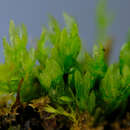Comments
provided by eFloras
Fissidens ventricosus occurs along the Pacific Coast of North America and at a disjunct site in northern Idaho (see map in R. R. Ireland and W. B. Schofield 1967). It is distinguished by its aquatic habitat, strongly limbate leaves, variably 2-stratose laminal cells, short, thick, geniculate seta, and emergent capsule. Plants usually become black and covered with diatoms. The species might be confused with F. rigidulus Hooker f. & Wilson, but the latter, found in wet sites in the Americas from Chile north to Mexico but not known in the United States, has much smaller laminal cells and a long seta characteristic of terrestrial species. The calyptra of F. ventricosus is cucullate according to Ireland and Schofield.
- license
- cc-by-nc-sa-3.0
- copyright
- Missouri Botanical Garden, 4344 Shaw Boulevard, St. Louis, MO, 63110 USA
Description
provided by eFloras
Plants to 25 × 3.5 mm. Stem unbranched and branched; axillary hyaline nodules absent; central strand weak. Leaves as many as 35 pairs, lanceolate to oblong-lingulate, acute to obtuse-apiculate; to 5 × 0.9 mm; dorsal lamina narrowed proximally, ending at insertion, not decurrent; vaginant laminae 1/2-2/3 leaf length, equal; margin ± entire, limbate on all laminae, limbidium reaching apex or ending a few cells before apex and a few cells above insertion of dorsal lamina, limbidial cells 3- to 6-stratose; costa ± percurrent, bryoides-type; laminal cells 1-stratose, or variably 2-stratose, smooth, slightly bulging, firm-walled, irregularly quadrate to hexagonal, 8-13 µm, ± twice as deep as wide. Sexual condition probably rhizautoicous; perigonia not seen; perichaetia on elongate stems. Sporophytes 1-2 per perichaetium. Seta stout, to 3 mm, geniculate. Capsule theca emergent, erect, radially symmetric, to 1.2 mm; peristome bryoides-type; operculum 0.4 mm. Calyptra not seen. Spores 23-40 µm.
- license
- cc-by-nc-sa-3.0
- copyright
- Missouri Botanical Garden, 4344 Shaw Boulevard, St. Louis, MO, 63110 USA

